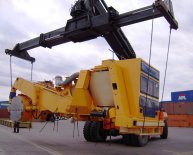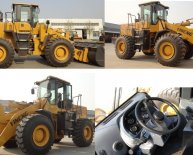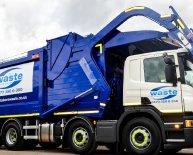
Front end Loader capacity
When purchasing a tractor, there are many variables to consider as well as many different manufacturers from which to choose. Each manufacturer offers several sizes of tractor rated by many methods such as Horsepower, Weight, Size and Lift Capacities. The key to buying the right size tractor is to know what you want to accomplish with your machine. Will it be used primarily for shredding? Or will you be moving material with a front end loader? How do you know what size is right for you? First, let’s talk about how “big” a tractor you need.
Horsepower
Horsepower is a common method by which to gauge a tractor’s size. In the old days, tractor horsepower was spoken of in terms of drawbar horsepower, meaning how much power the tractor transferred to the ground. As time went by, marketing departments of the manufacturers decided that PTO horsepower should be used, simply because it’s a higher number. Therefore, if a salesperson was describing his tractor with drawbar horsepower, the competing dealer would use PTO horsepower, a higher number, for the same size tractor.
This is happening again in the tractor industry, but instead of using PTO horsepower, the savvy marketing departments are quoting engine horsepower. Be careful about which horsepower you are talking.
How much horsepower do I need?
Unfortunately in our industry we see too many people over-sold on horsepower. It seems that many buyers believe a particular horsepower is the right size they are looking for, whether they have five acres, or five-hundred. Remember, you need to match the tractor to the job you want to do. If you want to operate a five-foot cutter (shredder), a good rule of thumb is 20 PTO horsepower (not engine horsepower). A six-foot cutter requires roughly 30 PTO horsepower.
A tractor used mostly for plowing and disking has many variables by which to judge, such as soil type, implements pulled and time allotted for the job. Talking to an experienced salesperson is the best option for help in sizing this type of equipment.
If the tractor will be used primarily for loader work, then determine if you need lift capacity, such as to lift a round bale of hay, or bucket capacity, to move a specific size load of dirt. There are many factors when deciding on a loader tractor which we’ll discuss further down the page.
Weight
When discussing the weight of a tractor, some manufacturers and dealers place heavy emphasis on this subject (no pun intended). The fact is, weight has little bearing on the quality of a tractor, and furthermore, no matter what brand, tractors do not break in half.
We have found when a manufacturer uses weight as their largest selling point it’s usually because their tractors have few other redeeming features. For instance, does that “heavier” tractor have a true independent (not just live) PTO with hydraulic engagement? Does it have a synchronized transmission with a shuttle? How does the size of the hydraulic pump compare? Does the front loader allow simultaneous operations of the loader and bucket? And most importantly, is the tractor viewed as a quality tractor in the marketplace?
Weight is the cheapest item a manufacturer can add to a tractor. If you want a heavy tractor, there are many options and ways to add weight to an existing tractor if that is important to you.
Size
The size of a tractor can be very deceiving when gauged simply by horsepower. These days, many manufacturers have experimented with high horsepower engines in small packages, as well as the inverse. Again, be careful when looking at just horsepower.
Some of the major manufacturers are now grouping their tractors into “Series” or “Classes” of tractors. Simply put, they use the same “chassis” for three or more different sizes of tractors and place different sized engines in them. What they get is a high-horsepower tractor in a small size tractor. This enables the manufacturer to have an inexpensive tractor for a given horsepower. Be careful judging these tractors just by horsepower, often you will not be comparing apples to apples.
Lift Capacities and Front Loaders
Lift capacity is probably the most deceptive gauge by which to compare tractors used in the industry. Whether it is lift capacity of the loader or three-point lift, often times the number quoted is not the weight the tractor can actually lift.
First, lift capacity can be measured by several different means. There is lift capacity to full height, static lift capacity, pivot pin capacity, bucket center capacity, lift arm capacity and 24 inches aft of lift arm capacity. Furthermore, we have seen several tests where the actual lift capacity of a tractor, whether front loader or three-point, will not come close to the number claimed by a manufacturer.
When considering a front end loader for your tractor, there are many cheaper “after-market” loaders in the tractor industry from which to choose. Be careful when inspecting the claims made by these other manufacturers. Usually there is a reason the loaders are less expensive. Often one loader model fits a dozen or more different tractors, but none exactly right. Every tractor has different hydraulic oil pressures and flows, as well as stress points on the frame. Many times the tractor warranty is void if a failure is found due to an aftermarket front loader.
Often times, these aftermarket loaders will not have a “regenerative valve” allowing simultaneous operations of the loader boom and bucket tilt. We recommend buying a loader produced by the same manufacturer as the tractor that is performance matched to a particular model tractor.
One more note on front end loaders: A trade-off exists between actual lift capacity and speed. If a front loader will lift what seems like a lot of weight, chances are it will have a very slow cycle time. Understand that when using a loader, cycle time is just as important as weight, as an operator doesn’t want to wait all day for the bucket to go up and down.

















